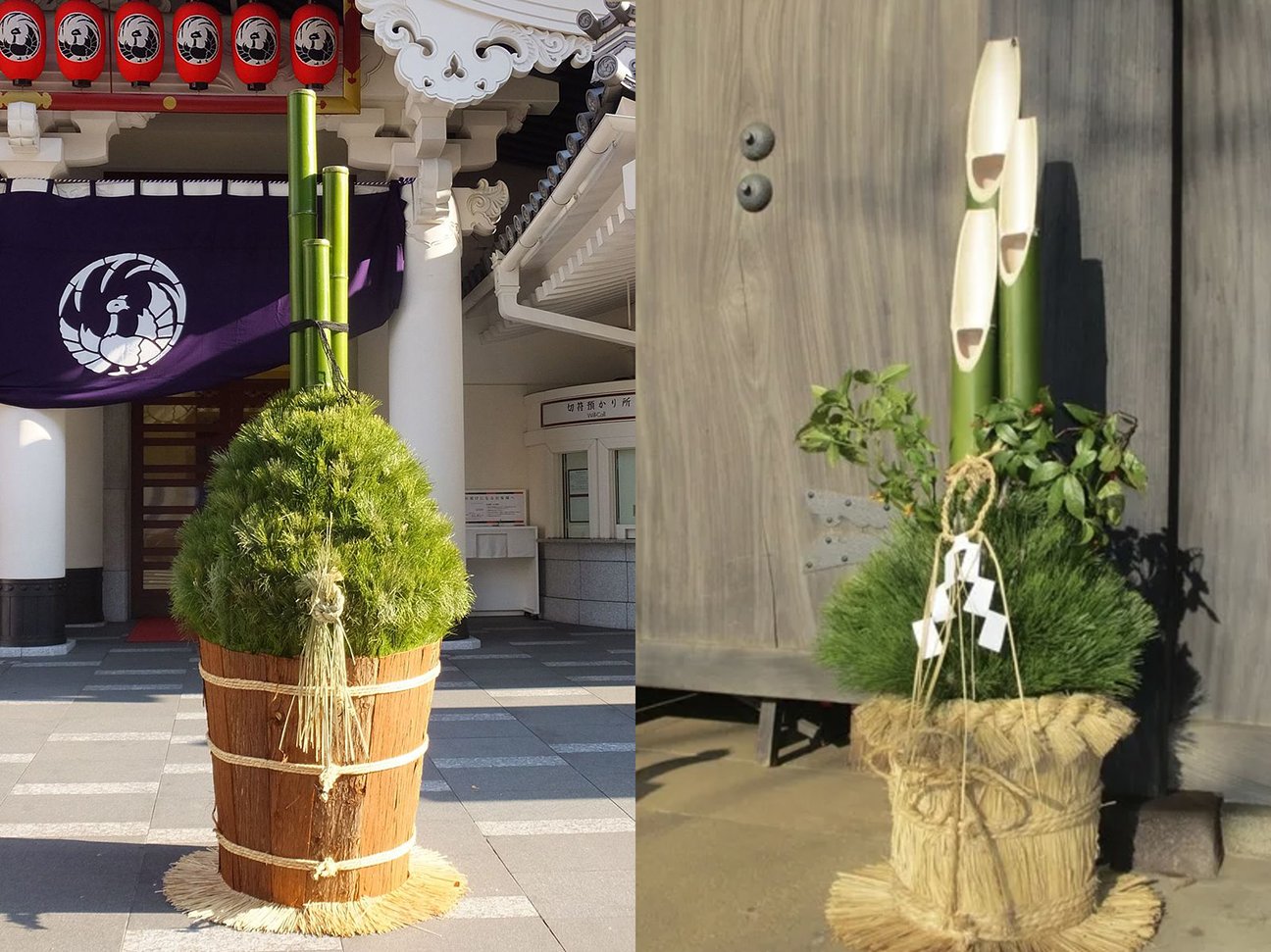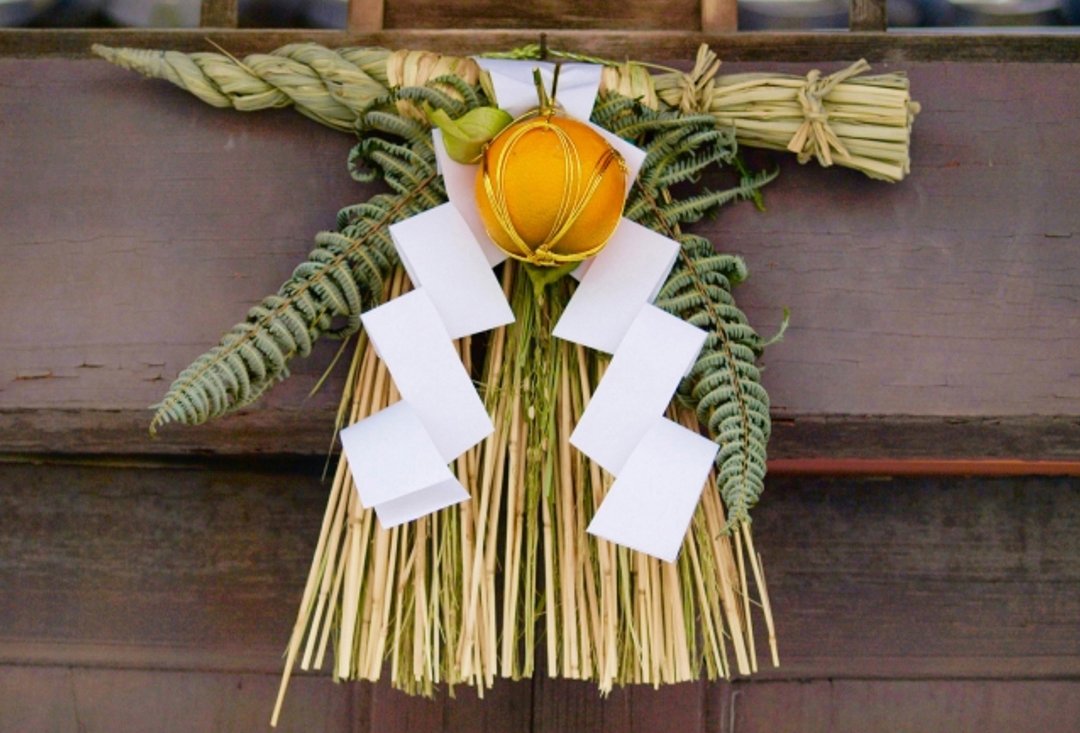Japanese New Year's Decorations
By Yukari Yamano
In Japan, January is considered to be the most important month of the year. Traditionally Japanese believe that Toshigami-sama (年神様 New Year’s deity) descends in the first month of the year and visits their home and leaves good luck for their coming year.
This deity is also called Toshitokujin (歳徳神), a deity who governs good luck of the year. He is believed to bring abundant harvest and good health. Some Japanese also think that the deity is their ancestor who ascended to mountains and became a spirit. Therefore, Toshigami-sama is not one specific deity and is considered to be gender free. In any case, Toshigami-sama is seen to bring happiness to families in Japan.
Japanese have special decorations for Toshigami-sama. Typical ones are Kadomatsu (門松, New Year’s pine and bamboo decorations), shimekazari (しめ飾り, Sacred straw festoon) and Kagamimochi (鏡餅, Round mirror-shaped rice cakes).
Kadomatsu (門松, New Year’s pine and bamboo decorations)
Kadomatsu (a pair of pine branch decoration for a gate, set out for New Years) from Wikipedia
Kadomatsu is a mark for Toshigami-sama to find a home that they are welcomed in. They only visit homes with Kadomatsu. A pair of Kadomatsu is set at the house gates. Typical Kadomatsu decoration has three plants: pine (松) branches, bamboos (竹) and plum (梅) sprigs. Three bamboos are put in the center surrounded by pine branches. Plum sprigs are added to them as an accent. They are bundled together with straws at the bottom.
Pine trees, bamboos and plum trees are auspicious plants in Japan. Even under the cold weather, pine tree’s green color does not fade. They are considered sacred and strong. Bamboos grow straight up and multiply one after another vigorously. They represent vitality and prosperity of descendants. Plum trees fleshly blossom in the cold weather and are a symbol of integrity. These plants are often used for ceremonies. In Japan, these three plants have been used as a theme for paintings and called, “Three Friends of Winter”.
Originally Kadomatsu was put together with only pines. From Muromachi period (1338–1573), Bamboos were added to it. Bamboos have two types of cuts. One is a flat cut at the joint and the other is diagonal slice. The diagonally sliced version has some interesting stories.
One episode comes from Tokugawa Ieyasu (徳川家康), a founder and first shogun of the Tokugawa shogunate, which ruled Japan during Edo-period (1603 – 1868). He lost his battle to Takeda Shingen (武田信玄, Known as the "Tiger of Kai" with exceptional military prestige) at the battle of Mikatagahara (January 25, 1573). This was his only loss in his battles. He was so mortified that he exclaimed to beat Shingen at the next battle and slashed off a bamboo with his sword — Ieyasu saw Take (a bamboo) as Takeda Shingen. This story is said to be the origin of Kadomatsu with diagonal cut bamboos.
The sliced bamboo surface can create a smiling face. Because of that, Japanese think diagonal cut is auspicious. There is a saying, “Fortune comes to the laughing gate” in Japan. And, this gate is Kadomatsu with diagonally sliced bamboos.
Shimekazari (しめ飾り Sacred straw festoon) and Shimenawa (しめ縄, Sacred braided straw rope)
Shimekazari (Shimenawa) Manner Up Magaizine
Generally, Shimekazari (Sacred straw festoon) and Shimenawa (Sacred braided straw rope) are used to indicate pure space for deities to reside. In Japan, at shrines, ritual sites and old trees, Simenawa is put in order to announce deities' existence. Did you notice that the big camphor tree in the movie, “My Neighbor Totoro” has a Shimenawa around it?
At New Year, Shimekazari is hung above the house gate or front door and at the family alter (if they have one) to welcome Toshigami-sama. The auspicious plants used for New Year’s Shimekazari are Urajiro (裏白, Gleichenia japonica, fern), Daidai (橙 Sapindales Rutaceae, orange), and Yuzuriha (譲り葉 Daphniphyllum macropodum).
Urajiro is a type of fern. Because the underside is white, it is considered to represent honesty. It also alludes to white hair which is a symbol of longevity. The fronds grew in pairs. They were seen as a faithful couple growing old together. Yuzuri in Yuzuriha means to hand over. Because the old leaves of Yuzuriha do not fall off until new leaves come out, they represent a long pedigree. Daidai is also written Daidai (代々), meaning “from generation to generation”. Daidai fruits are ripened during winter time and stay on the tree for a long time; sometimes more than a year, so the tree has multiple generations of the fruits together and that was seen as a symbol of family prosperity.
Kagamimochi (鏡餅, Round mirror-shaped rice cakes)
Kagamimochi with Skewered persimmons Kyoto University of the Arts
Kagamimochi is a set of two round mirror-shaped rice cakes, a small one is put on top of a large cake. The shape of Kagamimochi represents ancient copper mirror from Yayoi period (300BC – 250AD). The mirror was one of the Three Sacred Treasures in Japan. The mirror projected sunlight and was used as Yorishiro, the representative of the Sun Goddess, Amaterasu Omikami. Mochi which was made from rice was considered to be sacred and the round shaped rice cakes were regarded as Yorishiro for Toshigami-sama. Kagamimochi is put in an elevated alcove in a traditional Japanese room, or in an important location inside the house.
Addition to Urajiro, Daidai and Yuzuriha, Kushigaki (串柿, Skewered persimmons) can be added to Kagamimochi. There are two classes of Japanese persimmons: astringent and non-astringent. Non-astringent persimmons are sweet in fresh and astringent ones are bitter and cannot be eaten as they are. The persimmons used for Kushigaki are astringent. These persimmons, once dried, are sweeter than fresh non-astringent persimmons. They are the symbol of the great result of hard training. It says, “A bitter persimmon no one wants can become the decoration of the alcove at home when it is trained diligently”. With this Kushigaki, Kagamimochi represents the Three Sacred Treasures in Japan. Rounded rice cakes are the mirror. A bitter orange is the Jewel. And, a persimmon skewer is the sword.
To prepare for Toshigami-sama's arrival, traditionally Japanese clean and purify shrines, temples and houses on December 13th. After the cleaning is the beginning of the New Year. Japanese start decorating these special ornaments any time after December 13th. Usually, a preferred date is the 28th because the letter, 八(8) spreads toward the end meaning increasing success and is considered an auspicious number and also it is after Christmas day. Many families in Japan hang a wreath, decorate a tree and eat a cake to celebrate Christmas. They even get gifts from Santa!
The dates Japanese avoid are the 29th and 31st. The 29th is ominous. 2 represents twice and 9 which reads as “Ku” in Japanese is considered “Suffer”. The 29th was thought to be the day to invite doubled suffering. They also avoid the New Year’s Eve, because it is considered “One night decoration” which is the same process as Japanese funeral preparation and said to invite a bad luck.
Perhaps, for this coming New Year, the Seattleites can decorate their house with the Japanese traditional ornaments and auspicious plants to invite Toshigami-sama.
We wish you happy holidays.
Yukari Yamano is a special projects coordinator at the Seattle Japanese Garden, a native Japanese.




